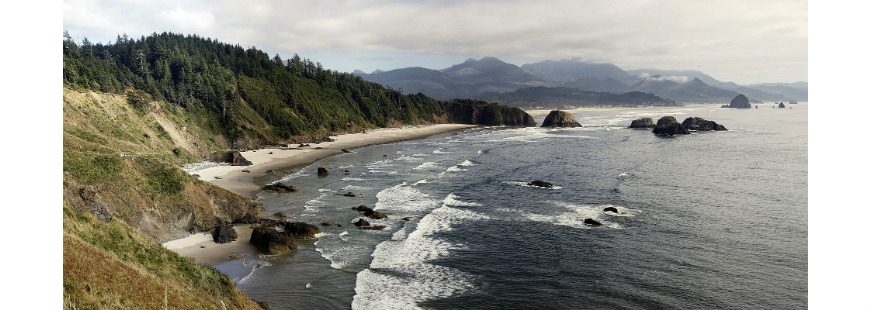Heading to the coast for fishing and fresh seafood
When the first heat waves in Oregon besiege the cities, it’s time to exit the Willamette Valley and head to the coast, where the ocean breeze is sure to satisfy, and not just in soothing temperatures.
Coming off of summer solstice (June 21), the theme of cusp (definition: At the dividing line or border of two conditions or categories) comes to mind. Like the west coast’s nearshore habitats, June often provides some of the best opportunities for fishers to take advantage of cusp month fisheries. Temperatures warm, plankton bloom and countless micro-organisms are pushed up into the water column for juveniles of all sorts of species to feed on and in turn, get preyed upon themselves. Many salmon fishers already know this, but it’s not uncommon for a salmon to gain a pound per week this time of year, when ocean conditions allow for it. We’re all hoping for a turn-around in ocean conditions; our returning salmon and steelhead need it as we witness the counter-productivity of slight returns of steelhead in the Columbia and Willamette River basins this year.
I might take the kids on a catch and release sturgeon trip this weekend, but ocean salmon opens up on Saturday, halibut, bottomfish, crab and soon, the albacore will be running. There’s so much swimming protein in the Pacific right now, many of us don’t know which way to turn when the tide allows. I’ve been having fresh pink shrimp nearly every meal by the way.
The mountains got their due attention this year, with a heavy snow-pack and ideal skiing conditions, and now it’s time for us to enjoy the ocean bounty as coastal communities suffered a low tourist season over the winter. Ask nearly any traveler at the coast why they decided to head west this weekend, and their first reaction might be to escape the heat, but their second priority will certainly be to enjoy some of the fresh seafood that will grace the region’s restaurants as we enter peak season.
When one understands all that we get to still enjoy from our salty sea, we have sound marine fisheries management to thank. The fact of the matter is, we’ve seen the low of lows and the high of highs, all in our lifetimes. It’s a bit befuddling to me… how we can have such wild fluctuations under what appears to be somewhat consistent conditions (less the drought of 2015 mind you) across our region?
Despite the salmon disaster declaration that Oregon and California senators called for in previous weeks, there are some good opportunities for salmon and a multitude of other species through the summer. It’s hard to feel all that good about harvesting in abundance, when our neighbors to the south will be going without for much of the year. One has to wonder, especially after coming off some really impressive salmon production in recent years, how did we get to this point?
Certainly, salmon having a short life-span doesn’t help. That certainly makes most short-lived species much harder to manage, and less resilient in years of fluctuating climate swings.
We have to feel fortunate, however, that we’re not going through the red snapper wars going on in the Gulf States right now. Managers seem willing to compromise this sensitive stock of fish to appease the recreational fleet, no matter what the cost. Of course we’re all about a fair allocation for the recreational fleet, but at the cost of future opportunity? We’ve tried that before; it doesn’t pay dividends.
I’m not really sure how politics were when Warren Magnuson and Ted Stevens were in office, but I think it’s safe to say, nowhere near as partisan as they are now. I do remember Senator Stevens was pretty pro industry, even the oil industry, much to the chagrin of the more liberal left. What can’t be overlooked, however, was the forward thinking vision these two change agents had to protect our ocean resources from what was certainly near the brink of disaster at that time. Relatively speaking, it didn’t take much time to fish down age-old stocks of fish once we gained the technology, which still advances fisheries technique nearly on a weekly basis.
We’ve seen it time and time again; fishermen are some of the most innovative minds of our time. We have figured out every conceivable way to take the last salmon, halibut, sturgeon or bottomfish from our waters, and it’s only federal law that prevents us from doing so. You don’t suppose foreign fleets would have ever had to ply what’s now US waters if they had had ample amounts of fish in their own home waters, do you? Although the Magnuson-Stevens Act didn’t establish the Exclusive Economic Zone that enables the United States to manage ocean waters out to 200 miles, it has been instrumental in establishing how the US can maximize profit for our country’s fishermen. I’m sure it’s still a rodeo in international waters.
So this summer, let’s appreciate the fact our west coast ocean fisheries are pretty well managed; we don’t have to go 200 miles offshore to catch a halibut or lingcod. Now is the time to take advantage of our ocean’s bounty, but be mindful, we have laws for a reason, so that future generations of fishers can experience the highs and lows of our resources also.


